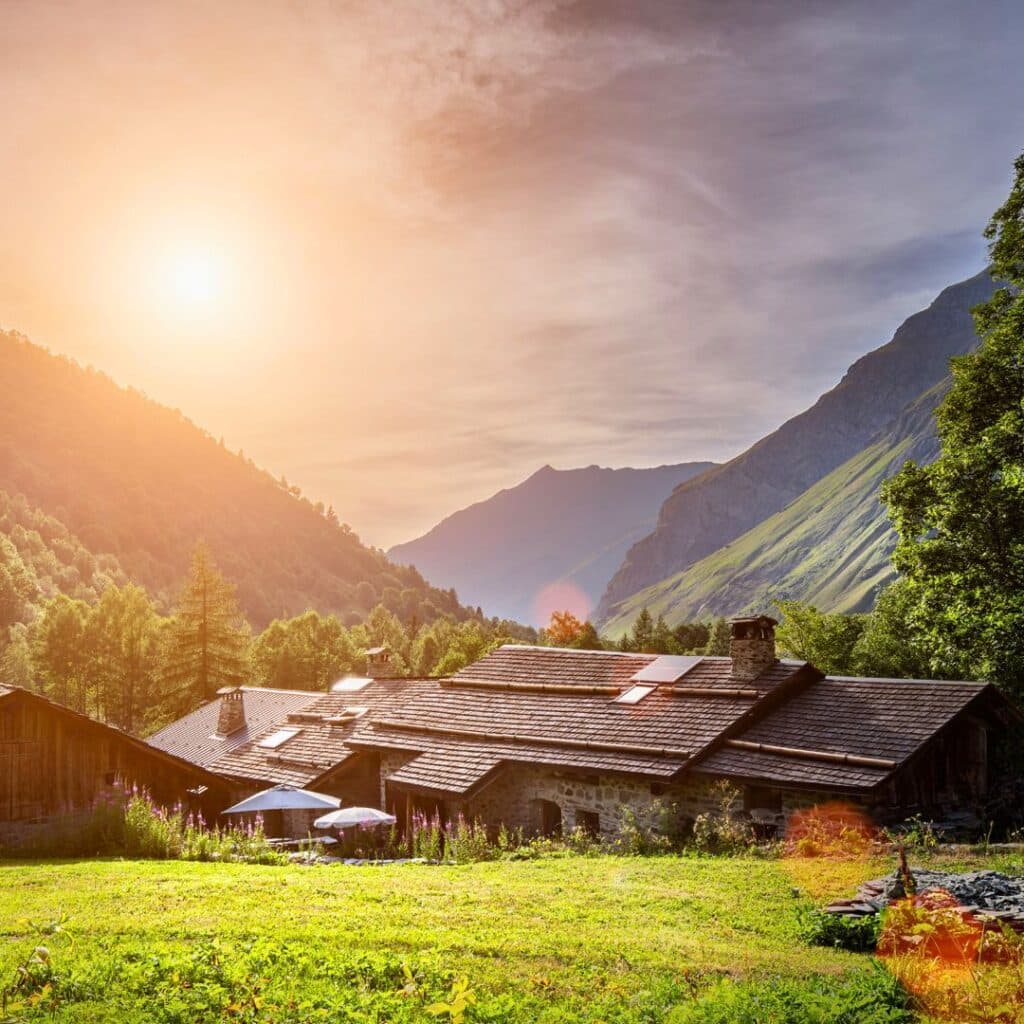That's La Plagne
Why Your Family Should Consider Staying in a Refuge During a Summer Visit to La Plagne

When most people think of La Plagne, they picture snow-covered slopes and winter sports. But La Plagne has so much to offer in the summer too, especially for families. One of the best-kept secrets of our alpine paradise is the network of mountain refuges. These cosy lodges aren’t just for winter—they’re perfect for a summer family adventure.
Join behind the scenes today and get the insider scoop
Why Stay in a La Plagne Refuge?
1. Access to Stunning Hikes
One of the main advantages of staying in a refuge is the immediate access to some of the most beautiful hiking trails in La Plagne. The refuges are often situated along well-marked paths that offer a range of hiking options, from gentle walks suitable for young children to more challenging routes for experienced hikers. Starting your hike right from your doorstep means you can get an early start and make the most of the daylight.
Hiking in the French Alps during the summer is a feast for the senses. The trails take you through verdant meadows, alongside crystal-clear streams, and up to high-altitude viewpoints where you can take in panoramic vistas of the surrounding peaks. Along the way, you’ll encounter a variety of alpine flora and fauna. Wildflowers bloom in vibrant colours, and you might spot marmots basking in the sun or eagles soaring overhead. These experiences are not only invigorating but also educational, especially for children who can learn about the natural world first-hand.
For families, many refuge’s offer guided hikes that are tailored to different skill levels and interests. These guided walks can be particularly beneficial if you’re unfamiliar with the area or want to learn more about the local ecosystem. The guides often share interesting facts and stories about the landscape, making the hike both enjoyable and informative.
2. Engaging Family Activities
Refuges in La Plagne are increasingly catering to families, offering a range of activities designed to keep everyone entertained. One of the highlights is the guided nature walks, which are suitable for all ages. These walks are a great way to explore the local environment and learn about the plants and animals that inhabit the region. The guides are usually very knowledgeable and can make the experience engaging and educational for children.
Another popular activity is treasure hunts. These are organised around the refuge and its surrounding areas, providing a fun way for children to discover the landscape. Equipped with maps and clues, kids can embark on an adventure, searching for hidden treasures while learning about navigation and teamwork. It’s a wonderful way to keep them active and entertained.
Many refuge’s also offer educational workshops. These can include anything from learning how to identify different types of wildflowers and animal tracks to understanding the basics of mountain safety and survival skills. Such workshops are not only informative but also help children develop a deeper appreciation for the natural world.
In addition to organised activities, there’s plenty of unstructured time for kids to simply play and explore. The safe, natural environment around the refuges is perfect for games, picnics, and discovering the wonders of the outdoors. Parents can relax knowing that their children are engaged in healthy, outdoor activities away from screens and modern distractions.
3. Taste Authentic Alpine Cuisine
One of the joys of staying in a refuge is the opportunity to enjoy authentic alpine cuisine. After a day of hiking and exploring, there’s nothing better than sitting down to a hearty meal. The food served in refuges is typically simple but delicious, made with local ingredients and traditional recipes that have been passed down through generations.
A typical meal might include dishes like tartiflette, a rich and comforting casserole made with potatoes, reblochon cheese, onions, and bacon. Soups are also a staple, often made with fresh vegetables and herbs. Bread is usually baked on-site or sourced from local bakeries, ensuring it’s fresh and flavourful. Desserts often feature seasonal fruits and regional specialities, providing a sweet end to the meal.
Meals in refuges are communal, which adds to the experience. Sitting around a large table, sharing stories and food with other guests, creates a sense of camaraderie and community. It’s a great way to meet new people, hear about their adventures, and perhaps even get tips for your next hike. For children, it’s an opportunity to make new friends and learn about different cultures and backgrounds.
Breakfasts are typically a hearty affair as well, with options like fresh bread and jams, yoghurt, cereals, and sometimes even a hot option like eggs. Starting the day with a good meal is essential, especially if you have a day of hiking ahead.
4. Learn About Local History
Many refuge’s in La Plagne have a rich history, often dating back to the early days of mountaineering and alpine tourism. These buildings were initially constructed to provide shelter for climbers and explorers tackling the high peaks of the Alps. Over the years, they have evolved into more comfortable lodgings, but they still retain much of their original charm and character.
Staying in a refuge gives you the chance to learn about the history of the region and the people who have lived and worked there. Some refuges have small museums or displays that showcase historical artefacts and photographs. These exhibits can give you a fascinating insight into the challenges and triumphs of early mountaineers and the development of alpine tourism.
The refuge staff are often a wealth of knowledge too. Many have lived in the area for years and can share stories about the local history and traditions. They might tell you about famous climbers who stayed at the refuge, or about significant events that took place in the region. This personal touch can make your stay even more memorable.
For children, learning about the history of the Alps can be both educational and inspiring. They can discover how people lived in the mountains in the past, what tools and techniques they used, and how the landscape has changed over time. It’s a great way to bring history to life and connect with the place you’re visiting.
5. Enjoy Wildlife Watching
The areas around refuges are rich in wildlife, making them ideal spots for nature lovers and budding naturalists. The French Alps are home to a diverse range of animals and birds, and staying in a refuge gives you the chance to see them up close. Early morning or late afternoon are the best times for wildlife watching, as this is when animals are most active.
One of the most iconic animals you might see is the marmot. These large, ground-dwelling rodents are often seen basking in the sun or scurrying around in the meadows. They are quite curious and sometimes allow you to get quite close before darting back into their burrows. Spotting a marmot can be a highlight for children, and it’s a great opportunity to teach them about the habits and habitats of alpine animals.
You might also see ibex, a type of wild goat with impressive curved horns. They are often found in rocky areas and are well adapted to the steep terrain. Watching these agile animals navigate the cliffs can be quite awe-inspiring. Other animals to look out for include chamois, deer, and a variety of birds such as eagles, buzzards, and ptarmigans.
Many refuge’s offer guided wildlife tours, which can enhance your experience. These tours are led by knowledgeable guides who can help you spot and identify different species, and provide interesting information about their behaviour and ecology. For children, these tours can be both fun and educational, sparking an interest in wildlife and conservation.
6. Relax and Unwind
One of the main benefits of staying in a refuge is the opportunity to disconnect from the hustle and bustle of everyday life and reconnect with nature. The peaceful, tranquil environment of the mountains is perfect for relaxation and rejuvenation. Without the distractions of technology and the pressures of daily routines, you can truly unwind and enjoy quality time with your family.
Refuges provide a simple, comfortable place to stay, where you can relax and soak in the natural beauty of the surroundings. Whether you’re sipping a hot drink while gazing at the mountains, reading a book in the cosy common room, or simply sitting outside and breathing in the fresh alpine air, the atmosphere is incredibly calming and restorative.
For children, staying in a refuge can be a refreshing change from their usual environment. Without the distractions of screens and electronic devices, they can engage in outdoor play, explore their surroundings, and use their imaginations. It’s a chance for them to experience the joys of nature and develop a deeper appreciation for the world around them.
That's La Plagne & Refuges in Summer
Staying in a refuge during your summer visit to La Plagne is an experience your family will treasure. From hiking and wildlife watching to enjoying local cuisine and learning about alpine history, refuges offer a unique and enriching way to explore the Alps. So, when you plan your next summer getaway, consider making a refuge your home base for adventure.
See you on the slopes!


Very informative . I didn’t know much about refuge. Surely want to stay in one of the refuges when I go to France
Absolutely! There are a really great way to see a different side to the mountains. I’m really keen to get to one with my kids soon. I think they will love it!